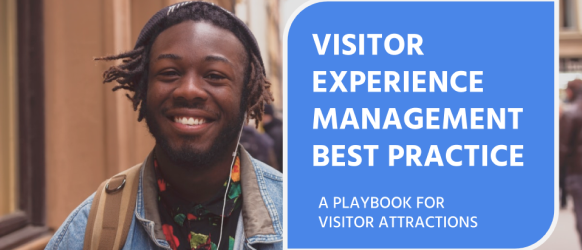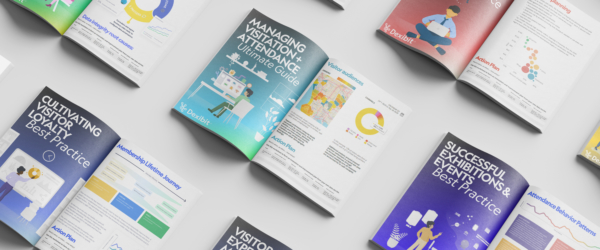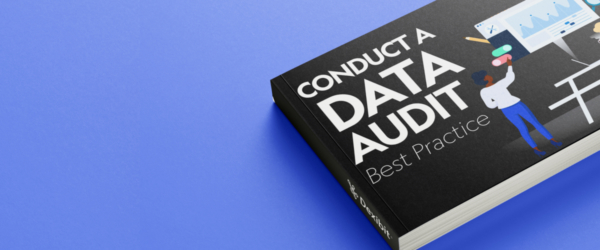Types of data to collect at your visitor attraction
- In Visitation Data
- Articles
- 5 min read
A common concern for visitor attractions contemplating a data program is that they don’t have ‘big’ data, or even ‘enough’ data. The opposite is often true – both commercial attractions such as theme parks and cultural institutions are incredibly data rich. You might be surprised at what types of data your attraction is already collecting – if you think your organization isn’t collecting much, look again.
When we look at the visitor’s experience and how they interact with your venue, the data opportunities are various. From what happens when a visitor comes onsite such as purchasing a ticket or being counted through footfall, to online activities such as web and social, to retail data through point of sale for merchandise or hospitality – there are plenty of data points gathered. Your venue may even have untapped data sources through elements such as your WiFi network, or components outside the venue such as weather or tourism.
Together, these sources all provide valuable insight – though often, data is buried in systems or spreadsheets, stuck in silos and underutilized. A visitor’s journey can be segmented into three different stages: discovery (when visitors are researching options and ‘before you visit’ information), engagement (time spent onsite) and retention (post visit or loyalty through membership or repeat visits). The challenge is to rescue and leverage this value across the visitor lifecycle by democratizing access and reducing time to insight.⠀
Discovery
During discovery, the types of data valuable to capture are those that answer, ‘how is our venue found?’ and ‘how effectively are we communicating to our visitor?’. Ultimately, insight should solve the attribution challenge, helping us to understand how many dollars it takes to bring a visit through the door, and where these are best spent for maximum return. This information can be found by analyzing metrics such as:
- Digital: For website performance, data via instrumentation such as Google Analytics provides traffic statistics, visitor demographics, referring sources and more. When thinking about what data is useful to source, keep in mind the need for tension metrics such as bounce rates and load times – for example, high website visits are irrelevant if most bounce before a call to action and long times spent on site could mean a site is slow to load or difficult to navigate. To minimize any risk of disruption to data, we recommend capturing social channel data straight from the source such as followers, impressions and reactions from Facebook, Twitter, Instagram and YouTube, even if your organization uses a variety of social media platform aggregator tools.
⠀ - Advertising: To understand advertising performance, especially for offline channels such as radio, billboard or direct mail, keep a track of campaign schedules and their budgets to contribute to the visitor acquisition cost picture and attribute comparative campaign performance.
⠀ - Public relations: In addition to paid advertising, a news mention feed such as via Google Alerts (RSS) helps to keep a track of press performance to understand the effect of media coverage on interest and visitation to your venue. Freeform notes documented against the data timeline can be used to link other public relations elements, such as documentaries or Trip Advisor rating announcements.
- Digital: For website performance, data via instrumentation such as Google Analytics provides traffic statistics, visitor demographics, referring sources and more. When thinking about what data is useful to source, keep in mind the need for tension metrics such as bounce rates and load times – for example, high website visits are irrelevant if most bounce before a call to action and long times spent on site could mean a site is slow to load or difficult to navigate. To minimize any risk of disruption to data, we recommend capturing social channel data straight from the source such as followers, impressions and reactions from Facebook, Twitter, Instagram and YouTube, even if your organization uses a variety of social media platform aggregator tools.
Engagement
During this stage, with guests onsite and engaging with activities such as experiences, exhibitions and events – data opportunities provide insights into how visitors commonly spend their time, how they explore the venue and how these journeys convert into commercial outcomes.
- Footfall: Footfall, either of the count of visitors coming into the venue or a specific space within it, can be gathered through manual methods or automated hardware. Tracking footfall is great for entrance analysis and understanding internal conversion into various zones, particularly shops, cafes or activities.
⠀ - Ticketing: Ticketing data may relate to general admission, specific activities or both, including advance passes sold online alongside walkup issue. Focus attendance and revenue analysis on ticket product, type and status combinations for visitor behavior, alongside origin, entrance, channel and other aspects.
⠀ - Point of sale: With the complex business model of visitor attractions including many other products aside from activities, point of sale data can be drawn from various other lines of business such as merchandise (including ecommerce), hospitality, accommodation and parking. This data helps complete the picture of average revenue per visit.
⠀ - Location analytics: Presence such as WiFi or even Bluetooth Low Energy (BLE) provides unique insight into visitor dwell times, pathways and repeat visits to understand common visitor behaviors and how these impact activity engagement, conversion rates and commercial outcomes. Experience activation, particularly ride usage, can be analyzed additionally using RFID tags, such as visitor wristbands.
⠀ - Reviews and evaluations: Capturing guest feedback and additional data through onsite or post visit surveys helps understand the qualitative view behind visitor behavior, as do Net Promoter Score (NPS) methods or online reviews from social media – which can also provide easy access to visitor commentary alongside compliments and complaints or staff reports. However, converting freeform remarks into quantitative metrics and processing these at scale can be tricky. Using natural language technology, analytics solutions such as Dexibit can provide a first pass process to reveal emotions, sentiment and themes and visualize word clouds or analyze trends.
- Footfall: Footfall, either of the count of visitors coming into the venue or a specific space within it, can be gathered through manual methods or automated hardware. Tracking footfall is great for entrance analysis and understanding internal conversion into various zones, particularly shops, cafes or activities.
In order to fully understand visitor behavior, in addition to the internal data your organization collects, take into consideration external data that can provide more context such as weather, regional events (summer vacation, federal holidays) and tourism (cruise ships). This helps understand what influences visitor decisions to visit, engage, spend and convert.
Two examples of analyzing external data on Dexibit. On the left, how how regional events impact visitation and on the right, how weather impacts visitation
⠀
Retention
Lastly, there are multiple opportunities to capture data even after your visitors have left – the retention stage presents insights around post visit engagement, loyalty and recurring revenue streams.
- Email marketing: Subscriber campaign performance from email marketing reveals the performance of a primary direct owned channel to encourage repeat visits or ecommerce activity. Data around open, click through and activation rates provides a view to the marketing funnel, alongside any split test improvements.
⠀ - Membership: Data from Customer Relationship Management (CRM) systems to manage members (or equivalent identified visitors, such as season pass holders) provides an important view into high value revenue streams which deliver compound growth. Analysis should focus on conversion versus retention and churn triggers, such as product, demographic, channel, payment type and origin.
⠀ - Repeat visit measures: WiFi and other methods can be used to track repeat visit rates alongside loyalty measures such as membership check ins. Repeat rates provide an interesting point of comparison against membership conversion to measure lost opportunity in product take up.
- Email marketing: Subscriber campaign performance from email marketing reveals the performance of a primary direct owned channel to encourage repeat visits or ecommerce activity. Data around open, click through and activation rates provides a view to the marketing funnel, alongside any split test improvements.
Understanding the data opportunity across the visitor journey and systems landscape of the visitor attraction is one of the first steps in starting a data program – and a place to return to for new opportunities as you progress in stages.
Deepening insight on visitors before, during and after their visits, onsite and online, whether within the grounds of your visitor attraction or out in the world – helps power the strategic and operational decisions behind efficient growth and delightful visitor experiences.
Want to learn more about Dexibit?
Talk to one of our expert team about your vision to discover your data strategy and see Dexibit in action.








